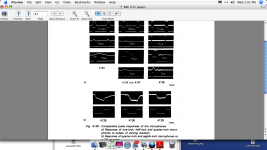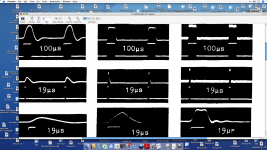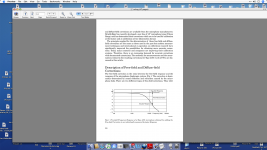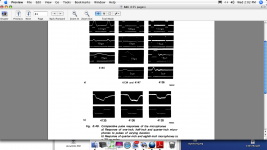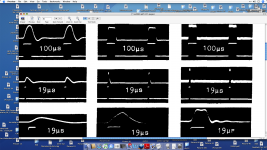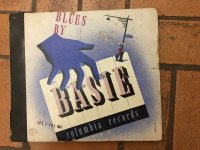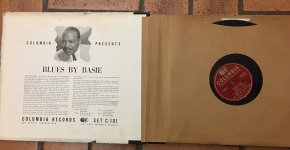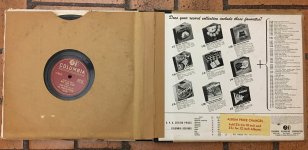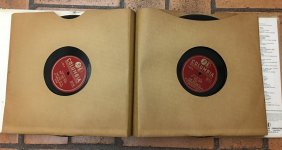Playback systems weren't too refined among cave dwellersaccurate direction finding as an evolutionary need I can understand. Not sure our savanna dwelling ancestors needed good jitter detection though
Even at the Rock age ?Playback systems weren't too refined among cave dwellers
If I could inject, I'd argue the "BS game" portion is trying to hang one's hat on the ostensible bandwidth above 22.1 to some sort of superiority. Sure, it's there, but, as you write, there's no energy in any recording to leverage it. And we only need as much rise time (bandwidth!) as our ears can hear anyhow, which makes the whole argument kinda null. Nor am I arguing that NOS 44.1 kHz digital doesn't need more bandwidth to get a decent antialiasing filter in there, which is largely obviated by oversampling.
There's a large element of the "make up the justification after you've decided the conclusion" that is getting push back.
Welcome to the groupies.
As i cited the original statement that got the "BS mark" , pointed to it as part of common knowledge and (at least implicitely) for an explanation several times there would be have been the opportunity to provide something; maybe of the kind that you expressed above.
But why should i have to conjecture about it?
Unfortunately it seem that in our days of "post factism" people tend to be less interested in arguments than in shouting . Does "it´s BS" and "no it´s not" in repetition really help?
Wrt your comment, the "plain BS" mark stil imo isn´t justified because how could you know?
You could point to the fact that it might be not important to each and everyone, but the mere technical fact can´t be disputet.
There is some evidence that bandwidth extension above 20 kHz (let´s say to 35/40 kHz) would possibly provide ""better" listener experience. Kunchur comes into mind (again) whose experiment could have provide corrobation for the results of the Leishovitz article Mark4 mentioned.
And of course, as said before, the assertion that something was "proven" by listening experiments can be refuted but it can´t be done by results of another listening experiment.
Guys, the problem with restricted bandwidth is that it significantly changes the transient response of music developed below 20KHz. Without somewhat extended above 20KHz bandwidth, we lose both rise-time and the time 'signature' of the original acoustic event. Is this important? I think so, based on my own listening experience. Now will it help EVERY audio system? Probably not, as many audio systems do not have extended 20KHz+ response, but that does not mean that it isn't audible with some people with more extended response.
Well, imagine a tweeter able to reproduce a 20kHz sinus at 0dB, but with a rapide slope after this frequency.Probably not, as many audio systems do not have extended 20KHz+ response, but that does not mean that it isn't audible with some people with more extended response.
Apply to it a sinus at 0dB peak or a square wave at 0dB peak. Where is going the extra power in the square wave ?
How? That doesn't make sense at all, John.
They're interrelated and bandwidth limited by microphones already. This is all classic signal theory. If you want to go about step responses without reconstruction filters, fine, but then you're in a place where you've long since violated sampling theory. Certainly some overprovision is good to ensure we don't get too time-variant of response, but wouldn't time variance show up as gross distortions (not necessarily harmonic)?
They're interrelated and bandwidth limited by microphones already. This is all classic signal theory. If you want to go about step responses without reconstruction filters, fine, but then you're in a place where you've long since violated sampling theory. Certainly some overprovision is good to ensure we don't get too time-variant of response, but wouldn't time variance show up as gross distortions (not necessarily harmonic)?
Last edited:
Here is the transient response of the B&K microphone that we all settled on 45 years ago as a 'reference' condenser mike: The 1/2" B&K 4133. The GD, Mark Levinson, Crystal Clear, and Stellavox used it as their primary mike in the '70's. It is the MIDDLE row of screen shots. Fast enough for most things, BUT we could do faster with a smaller mike width, if necessary.
Attachments
Derfy,
Even the 40s and 50s had condenser and ribbon microphones that had response above 20,000 hertz. They often were deliberately resonant at 15,000 hertz or so as they really were voiced by ear. But having played with them they really did peak there and then have extended high frequency response.
I lost one of the vacuum tube condenser microphones in a flood. It had a gold diaphragm. Gold was chosen as it is possible to roll it thinner than any other metal.
RCA used to make different ribbon microphones their limit was the step up transformer.
Even the 40s and 50s had condenser and ribbon microphones that had response above 20,000 hertz. They often were deliberately resonant at 15,000 hertz or so as they really were voiced by ear. But having played with them they really did peak there and then have extended high frequency response.
I lost one of the vacuum tube condenser microphones in a flood. It had a gold diaphragm. Gold was chosen as it is possible to roll it thinner than any other metal.
RCA used to make different ribbon microphones their limit was the step up transformer.
Last edited:
Gold was chosen as it is possible to roll it thinner than any other metal.
I can only imagine there is an issue with resistance to damage, that amount of culinary gold leaf is only a few dollars.
And yet, still there's basically no music that has any energy up there. And many of the other classic microphones (not saying all!) are pretty much dead at 10k.
By and large the most popular classic condensers were the 1" ones with a resonance around 5k carefully controlled and damped with the backplate holes.
And yet, still there's basically no music that has any energy up there. And many of the other classic microphones (not saying all!) are pretty much dead at 10k.
Even with drums there is this shinny brass disc floating above the boomy thingies. It seems to go a bit high. More so when brushed. A few mire gizmos on the band stand also go well above 20,000 hertz.
But if your world is all solid body electric guitars, maybe not.
I can only imagine there is an issue with resistance to damage, that amount of culinary gold leaf is only a few dollars.
Actually the culinary stuff I use is about a dime a sheet. Never though about trying it as a microphone diaphragm.
The actual microphone clearly had a taut gold colored diaphragm. It was an old Western Electric design. I got it because it was used as a pulpit microphone that whenever moved made horrible noises.
Turned out to be a bad solder joint on the case. Mechanical connection only.
I lost one of the vacuum tube condenser microphones in a flood. It had a gold diaphragm. Gold was chosen as it is possible to roll it thinner than any other metal.
B747/200 cockpit front windscreens had a layer of gold between the two most outboard layers of glass/acrylic so thin that it was transparent to light with a light yellow hue.
I can’t remember the thickness but I do remember what was written on the TM that the sheet had been thinned by mechanical means (i.e. no plasma deposition)
George
I'm afraid that this chit-chat about microphones is going astray. Yes, Scott, a 1'' microphone has resonance well within the audio bandwidth, BUT the proximity effect of the microphone body makes up for this to make a response from 15KHz-40KHz with real microphones like what we often use. The microphone rise-times that I put up still hold, and a B&K 1" microphone is essentially flat up to 20KHz, AND it does not fall off like a rock after 20KHz. Here is the difference between the resonant frequency response and the ACTUAL response of condenser microphone.
Attachments
Last edited:
If I could inject, I'd argue the "BS game" portion is trying to hang one's hat on the ostensible bandwidth above 22.1 to some sort of superiority. Sure, it's there, but, as you write, there's no energy in any recording to leverage it. And we only need as much rise time (bandwidth!) as our ears can hear anyhow, which makes the whole argument kinda null. Nor am I arguing that NOS 44.1 kHz digital doesn't need more bandwidth to get a decent antialiasing filter in there, which is largely obviated by oversampling.
There's a large element of the "make up the justification after you've decided the conclusion" that is getting push back.
Yes!! Darn that Stewart Hegeman! He was researching that back in the 1950s
and 1960. Low distortion and wide bandwidth. In his tests people couldn't
hear it, but they chose consistently the wide bandwidth...23 to 55kHz (cps
in those days) and a frequency response from something
like 2 or 5 Hz all they way to 90 to 95kHz.
And so back to the future bandwidth greater than 22.1 k is what? useless?
worthless? Ok I see, oversampling will render it "recorded" "music"?
Heck any one have a good 78 player? I've got some original "Les Paul",
"Billy Holiday" the Count as in BASIE along with some others too.
I got the film, almost 11:00.
Cheers,
PS - I have vials of pure GOLD, Ed,
these all in nice hammered out little rolls too.
Maybe you can roll your own...
...legal now in California.
What do you call that thin air chamber in a mic?
We gotta learn us some of dat there afixin' it to!
George, that is EMI hardened I think. So when
old flat top launches him and airburst...
that there flyin' mac-Eyene, will still be aloft.--I rekon.
Attachments
Last edited:
And yet, still there's basically no music that has any energy up there. And many of the other classic microphones (not saying all!) are pretty much dead at 10k.
Isn´t that more an argument from the "status quo" point of view?
We know that there are instruments that produce energy output above 20 kHz and others do not.
There is some evidence that humans might prefer an extended bandwidth above 20 kHz.
Remember the experiment (linked earlier) that Olson in the 1950s did, when people preferred lower bandwidth <10kHz .
So, as usual, what is needed are more replications and additional experiments to figure out what is beneficial wrt the circumstances.
@ SyncTronx,
do you have some more information about the tests you´ve mentioned?
I must admit having never heard of Stuart Hegemann.
I realize you guys are trying to take me to the task, but do remember this stems from an off hand comment about the importance of rise time in musical "Dynamics".
There's also Richard Lee's work that people preferred lower bandwidth for amplifiers. More or less I'd call the latter non-definative.
Anyhow I'm not really advocating much past any talk of wide bandwidth media and playback (with the red herring of rise time) is both an edge case in specialized recordings and actual music. For all the talk of musical instruments, just how much energy is up there? Yes it certainly is important and adds effect but there's not much up at the top and it sure as heck isn't a unit step function.
There's also Richard Lee's work that people preferred lower bandwidth for amplifiers. More or less I'd call the latter non-definative.
Anyhow I'm not really advocating much past any talk of wide bandwidth media and playback (with the red herring of rise time) is both an edge case in specialized recordings and actual music. For all the talk of musical instruments, just how much energy is up there? Yes it certainly is important and adds effect but there's not much up at the top and it sure as heck isn't a unit step function.
I realize you guys are trying to take me to the task...
A Wikipedia definition: "To take to task is to chew someone out for something they've done wrong. If you don't do your homework for a week, your teacher will take you to task, and you better straighten up! A task is a job, and if someone takes you to task, they're letting you know you did a bad job."
I don't think that's it. I don't think most people's responses were intended as efforts at winning a debate either.
You're right Mark, for some reason I thought "take someone to task" was less harsh than its true definition. I didn't take people as being combative.
More or less I didn't think I made too controversial a comment to say that there's little energy up high in the audio bandwidth both in terms of band limiting by microphones and various other natural and artificial processes. Thus swearing by its importance is questionable at best.
And that is ignoring whether any such extra bandwidth is audible to even the best.
More or less I didn't think I made too controversial a comment to say that there's little energy up high in the audio bandwidth both in terms of band limiting by microphones and various other natural and artificial processes. Thus swearing by its importance is questionable at best.
And that is ignoring whether any such extra bandwidth is audible to even the best.
- Status
- Not open for further replies.
- Home
- Member Areas
- The Lounge
- John Curl's Blowtorch preamplifier part II
